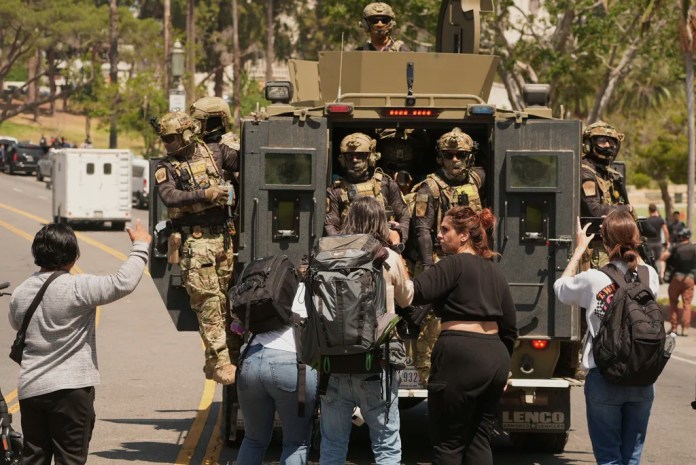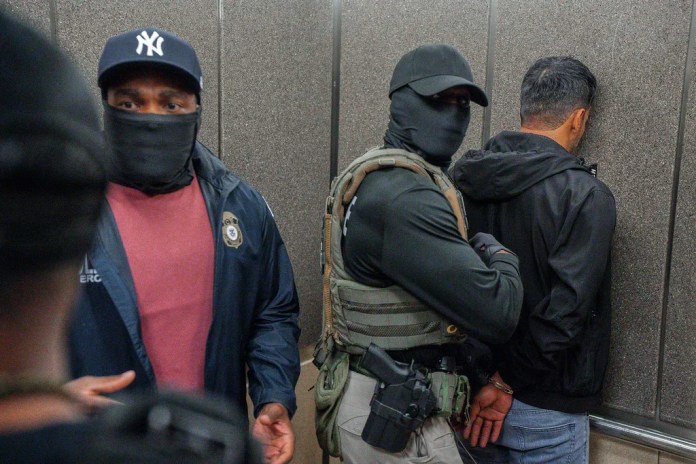Immigration and Customs Enforcement and Border Patrol are fighting over who is better-suited to carry out President Donald Trump’s deportation operation.
This week, the fight devolved into a public blame game that has gotten uglier every day.
Border Patrol agents who spoke with the Washington Examiner earlier this week had criticized ICE officers for being unable to meet the moment and arrest more illegal immigrants for deportation. Those agents went as far as to say ICE was to blame for releasing millions of illegal immigrants into the United States from the Mexico border during the Biden administration.
But an ICE official responded, in a new statement to the Washington Examiner, with a counterattack that blamed the Border Patrol for the state of illegal immigration.
“Border Patrol let tens of millions of illegal aliens flow across the border during 4 years under Biden,” the ICE official wrote in a message. “Almost every illegal alien ICE has arrested in the interior who came in during those years was handed a piece of paper by Border Patrol and sent on their merry way to a U.S. city near you. Border Patrol created this mess, and ICE is cleaning it up.”
Border Patrol and ICE have long been partners in immigration enforcement. Both are part of the Department of Homeland Security.
DHS Assistant Secretary Tricia McLaughlin attacked the Washington Examiner for its reporting on dissent among employees and leaders of both agencies.
“As much as you and the media may salivate over some fantasy of division, there is none. One team, one fight,” McLaughlin wrote in a statement. “Your manufactured narrative is getting boring. I’m happy to put my name behind what I say, unlike your nameless sources.”
Border Patrol is stationed at the nation’s land border, while ICE is spread out across two dozen regions nationwide. Congress has tasked Border Patrol with apprehending any goods, vehicle, or person who attempts to enter the United States without being inspected at a port of entry, while ICE is supposed to arrest illegal immigrants inside the country and initiate the deportation process in court. Ultimately, if a judge approves deportation, ICE will transport that person to his or her country of origin.

At a time when the Department of Homeland Security is trying to ramp up illegal immigrant arrests, ICE has come under fire for not achieving the White House’s goals to blow previous years of deportation numbers out of the water and set a new record during Trump’s second term.
The White House has emphasized the desire to hit 1 million deportations before January 2026, but is on par to hit 600,000, and even that figure has been described by immigrants rights advocates, including the American Immigration Council, as being blown out of proportion.
With ICE falling short of that goal, Border Patrol agents were sent in to some cities to help ICE this summer.
In September, the first group of Border Patrol agents arrived in Chicago. In a flashy procession, agents in tactical gear were paraded through downtown Chicago as if to make a statement that they were ready to crack down on illegal immigration absent cooperation from the city’s Democratic Mayor Brandon Johnson, who has turned over fewer than 10% of illegal immigrants arrested by local police to ICE since January.
On Oct. 15, Border Patrol Chief Mike Banks told the Washington Examiner in an interview that his agents had quietly expanded to more than 27 cities to help ICE.
“We have a significant amount of United States Border Patrol agents assisting ICE on op-at-larges in multiple cities, not just your Chicago’s and your L.A.’s, but in 27-plus cities across this country where we are working on the interior,” Banks said.
https://t.co/Rk2OuyD4A1 pic.twitter.com/O6hcJd1ESZ
— Anna Giaritelli (@Anna_Giaritelli) October 15, 2025
The claim that ICE is in dire need of help has not sat well with ICE. An ICE official contacted the Washington Examiner on Wednesday evening to dispute Banks’s claim and said, “Border Patrol is not supporting ICE in 27 cities.”
Border Patrol responded on Thursday afternoon that at the time of the interview, it had agents in “nearly 27 cities” and that as of Thursday, its agents were helping ICE “in 18 major cities … on a regular basis.”
Border Patrol agents are presently helping ICE in Atlanta; Boston; Dallas; Detroit; El Paso, Texas; Harlingen, Texas; Houston; Miami; Minneapolis; New Orleans; New York City; Newark, New Jersey; Philadelphia; Phoenix; Salt Lake City; San Antonio; San Diego; and Seattle, the Border Patrol told the Washington Examiner.
Border Patrol agents explained to the Washington Examiner on Wednesday that they are irritated with ICE for not being able to arrest as many people as were released into the country, particularly those with criminal histories.
Several ICE personnel shared with the Washington Examiner this week that they are not happy about the idea of having to work for Border Patrol leaders after the DHS opted to move in Border Patrol officials over to ICE to devise and carry out arrests. Border Patrol is going out of its way to step into ICE’s territory, which has irked some ICE.
ICE officers are assigned to offices nationwide and go out into the community together to arrest specific individuals, while Border Patrol agents often work alone or with a partner in remote areas. They attend different training academies, but ultimately deal with the same population of people in the country illegally.

The agents that Border Patrol has sent in to Chicago and Portland are from its special operations and tactical units, which means they have significantly more training in navigating dangerous situations than their peers.
Additionally, the slowdown at the southern border since Trump took office has freed up Border Patrol such that the number of agents offering to deploy to cities to arrest illegal immigrants at-large is very high, according to Banks.
Separately, some immigration analysts are concerned with the Trump administration’s decision to bring in Border Patrol agents to help on the ground in cities, as well as with its effort to move Border Patrol leaders into ICE to make decisions on a matter that is outside their normal wheelhouse.
David Bier, director of immigration studies at the libertarian Cato Institute in Washington, said Border Patrol’s sending in its own personnel to work alongside and even inside ICE is cause for concern.
“We are seeing the breakdown of the separation between Border Patrol and ICE. This is just one example of the total collapse in the barriers between agencies and departments across the federal government,” Bier wrote in an email. “The White House is attempting to centrally control deportation operations and force even Justice Department agents to work as deportation officers under DHS control.”
Whether the Department of Homeland Security is quietly moving to combine Border Patrol’s overseeing agency, U.S. Customs and Border Protection, with ICE remains unclear. However, the Heritage Foundation’s Project 2025 called for both agencies to be combined along with U.S. Citizenship and Immigration Services.
McLaughlin did not specifically address a request from the Washington Examiner for comment on whether the department was in the process of combining agencies, as outlined in Project 2025.
“This is dumb and manufactured to write a story where there is none. Next question,” McLaughlin said in a statement Thursday afternoon. CBP and ICE did not comment.
TRUMP ADMINISTRATION QUIETLY PURGES ICE LEADERS IN FIVE CITIES: SOURCES
Aaron Reichlin-Melnick, senior fellow at the American Immigration Council, said even if the Trump administration wanted to shuffle DHS agencies around, it would not be up to the DHS or White House — it would have to come from Congress.
“ICE and the Border Patrol have always been separate agencies, even though they both carry out immigration enforcement,” Reichlin-Melnick said. “It would take an act of Congress to combine the two agencies.”

